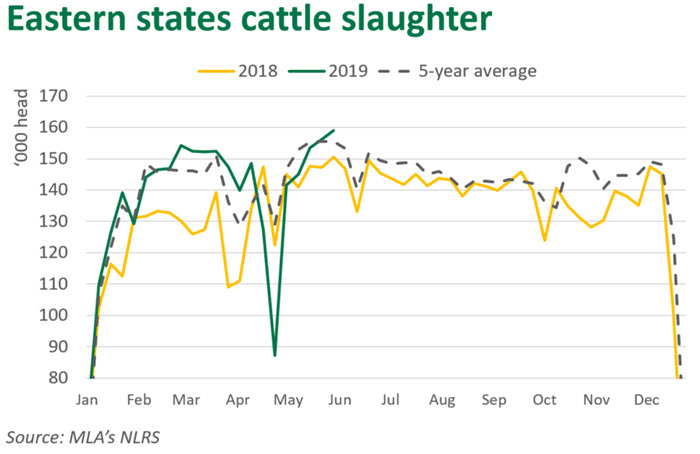As dry conditions persist across much of the country, weekly cattle slaughter rose to levels not seen since 2015.
Key Points
- Cattle slaughter has seen a notable uptick in recent weeks
- Most categories saw weekly price gains despite deteriorating conditions
- Heavy steers and cows supported by global beef demand
Slaughter
With autumn rain deemed largely a failure in most regions, further destocking of the breeding herd occurred during May. Eastern states weekly slaughter totalled 159,000 head last week, up 2% on the week prior and up 6% on the same week in 2018.

Elevated female slaughter points to the continuation of a significant liquidation phase in the national herd and market reports confirm the prevalence of cows at recent sales. When conditions do improve, breeding stock will find price support, as restockers compete for the limit supply.
NLRS slaughter data provides a breakdown of slaughter by sex for the states of NSW and Queensland and the data confirms a trend of heightened female slaughter.
During the last four weeks, weekly slaughter averaged 153,000 head per week in the eastern states, up 6% on the same period in 2018. In NSW and Queensland, an average of 60,000 females were slaughtered per week over this same period – up 16% on 2018.
At this level, female slaughter in NSW and Queensland remains below the highs of May to June 2015, when an average of 62,000 females were slaughtered per week. That said, the current high numbers are being derived from a smaller national herd.
Prices
While many regions are yet to receive a decent break in the season, the store market saw a slight improvement during the week. Heavy steers and cows remain elevated when compared to year-ago levels, supported by strong global demand and a low Australian dollar.
The Eastern Young Cattle Indicator (EYCI) rose 4% week-on-week, to 487¢/kg carcase weight. While the EYCI remains slightly above year-ago levels, the overall lack of restocker competition has kept the indicator 6% below the five-year average.
Feeder steers rose 2% this week to 289¢/kg live weight (lwt), which is up 6% year-on-year and in line with the five-year average. Due to feed shortages and a poor weather outlook, uncertainties surround the potential supply of quality feeder cattle this winter, which may add a level of support to prices in the coming months.
The eastern states medium cow indicator saw a modest gain of 1% this week to 185¢/kg lwt, 9% above year-ago levels. Despite the emergence of an easing trend since April, the US imported 90CL indicator remains 15% above year-ago levels (in Australian dollars). This, combined with strong demand stemming from China, has aided domestic cow prices, despite heightened supply.
Heavy steers rose 3% during the week, averaging 296¢/kg lwt on Tuesday, which is up 10% year-on-year and up 11% on the five-year average.
© Meat & Livestock Australia Limited, 2019
You are not permitted to re-transmit, alter, distribute or commercialise this article or its contents without seeking prior written approval from Meat & Livestock Australia Limited.






